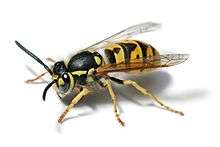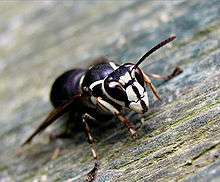Characteristics of common wasps and bees
While observers can easily confuse common wasps and bees at a distance or without close observation, there are many different characteristics of large bees and wasps that can be used to identify them.
| Bees | Wasps (Family: Vespidae) | |||||||
|---|---|---|---|---|---|---|---|---|
| Name | Western honey bee | Africanized honey bee | Bumblebee | Yellow Jacket | Paper Wasp | Bald-faced hornet | European hornet | Asian giant hornet (Japanese giant hornet) |
| Image |  |
 |
 |
 |
 |
 |
 |
 |
| Colors | Amber to brown translucent alternating with black stripes.[1] (video) Exact pattern and colouration varies depending on strain/breed. | Amber to brown translucent alternating with black stripes. Slightly smaller than western honeybee.[1]
(video) |
Yellow with black stripes, sometimes with red tail, to dark as in Bombus pratorum.[2] | Black and opaque bright yellow stripes. (video) | Dusty yellow to dark brown or black. (video) | Black and ivory white markings. (video) | Black and dark body with yellow.[3] (video) | Black and gold body with orange. (video) |
| Coat | Furry (short hair). | Furry (long hair). | Little or no hair. | Some hair. | ||||
| Size | 1.3 cm (0.51 in) | 2.5 cm (0.98 in)[4] | 1.3 cm (0.51 in) | 1.9 to 2.5 cm (0.75 to 0.98 in) | up to 3.0 cm (1.2 in) | up to 3.5 cm (1.4 in) | up to 4.0 cm (1.6 in) | |
| Legs | Not generally visible while flying.[5] | Two thin long legs are visible hanging down during flight.[6] There are no pollen baskets. | ||||||
| Behavior | Gentle.[7][8] | Extremely Aggressive.[9] | Gentle.[10][8] | Aggressive.[8] | Extremely Aggressive [8][11][12][13] | |||
| Food | Pollen and nectar from flowers. | Other insects, overripe fruit, sugary drinks, human food and food waste, meat.[14] | Other insects. | |||||
| Sting | "Kills bee;[15] continues pumping. Barbed. | Retracts; can repeat. Smooth. | ||||||
| Sting Pain | 2.0 | 2.0 | 2.0 | 2.x | 3.x | 2.5 | 2.x[16] | 4.0+[17] |
| Lights | Not attracted to lights at night unless nest is disturbed, or light placed near hive. | Attracted to lights at night. | ||||||
| Lives in | Large colonies of flat, wax-based honeycomb hanging vertically. | Small cavities in the soil. | Small umbrella-shaped papery combs hanging horizontally in protected spaces such as attics, eaves or soil cavities. | Large paper nest, upside down pear shaped, hanging from branches and eaves.[18] | Very large paper nest in hollow trees, sheltered positions.[19] | |||
See also
Notes and References
- 1 2 that is in general. Some are mostly black
- ↑ Benton, Ted (2006). "Chapter 9: The British Species". Bumblebees. London, UK: HarperCollins Publishers. pp. 338–342. ISBN 0007174519.
- ↑ there are different geographic colour forms
- ↑ or more
- ↑ Light-colored pollen on the pollen baskets on a honeybee's rear legs can be visible.
- ↑ This generally only applies to paper wasps. Yellow jackets' legs are not generally visible while flying.
- ↑ Domesticated bees have been selected over time for gentleness. There are several races of domesticated honey bees with varying characteristics of honey production, disease resistance and gentleness.
- 1 2 3 4 Agressive hive defense
- ↑ Swarm more easily than European honeybees and can chase victims for significantly longer periods.
- ↑ Domesticated bees have been selected over time for gentleness. There are several races of domesticated honey bees with varying characteristics of honey production, disease resistance and gentleness.
- ↑ Ross, Piper (2007). Extraordinary Animals: An Encyclopedia of Curious and Unusual Animals. pp. 9–11. ISBN 978-0-313-33922-6.
- ↑ http://news.nationalgeographic.com/news/2013/10/131004-giant-hornet-insects-attacks-china-animals-science/
- ↑ http://www.cnn.com/2013/10/03/world/asia/hornet-attack-china/
- ↑ Yellow jackets are carnivorous during the brood rearing part of the season. They feed insects to their brood, and obtain the sugar for their flight-muscle energy mostly from secretions of the brood. During this time they can be attracted to traps baited with meat or fish. Near the end of summer, when brood rearing ceases and this sugar source is no longer available, yellow jackets become frantic for sugar, and can be baited with sugar-based baits. They are also much more likely to visit fall flowers for nectar, than they are earlier in the season.
- ↑ Since the barbed stinger evolved as a colony defense against vertebrates, the invariable outcome of stinging a mammal or bird is that the stinger becomes lodged in the victim's skin and tears free from the honey bee's body, leading to her death within minutes. As such, there is rarely any evolutionary advantage for a bee to sting a mammal to defend itself as an individual; honey bees will generally only sting when the hive is directly threatened and honey bees found in the field or on a flower will rarely sting.
- ↑ mainly European hornet. Other species may be more aggressive and have a more toxic sting.
- ↑ http://www.vespa-crabro.com/vespa-mandarinia.htm
- ↑ Also barns, attics
- ↑ Has a brown, protective layer when the nest is in an unsheltered position. Also barns, attics, hollow walls and abandoned bee hives
Further reading
- N. R. Levick; J. O. Schmidt; J. Harrison; G. S. Smith; K. D. Winkel (2000). "Review of bee and wasp sting injuries in Australia and the U.S.A. § Bees versus wasps: Appearance, Behaviour, and Venom chemistry". In Andrew D. Austin; Mark Dowton. Hymenoptera: evolution, biodiversity and biological control. Csiro Publishing. pp. 439–440. ISBN 978-0-643-06610-6.
- P. Gopalakrishnakone (1990). "Differences between wasps and bees". A Colour guide to dangerous animals. NUS Press. p. 47. ISBN 978-9971-69-150-9.
- Philip B. Mortenson (2008). "Bee · Wasp · Hornet · Ant". How to tell a turtle from a tortoise: a close look at nature's most confusing terms. Barnes & Noble. ISBN 978-0-7607-9002-1.
- Kevin T. Fitzgerald; Rebecca Vera (2006). "Insects — Hymenoptera". In Michael Edward Peterson; Patricia A. Talcott. Small animal toxicology (2nd ed.). Elsevier Health Sciences. ISBN 978-0-7216-0639-2.
External links
- Ohio State University Yellowjacket factsheet
- Ohio State University Hornet factsheet
- What's Buzzin' in My Garden?
- Differences between wasps and bees poster
This article is issued from Wikipedia - version of the 11/25/2016. The text is available under the Creative Commons Attribution/Share Alike but additional terms may apply for the media files.